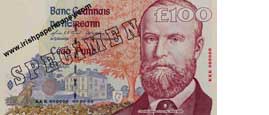
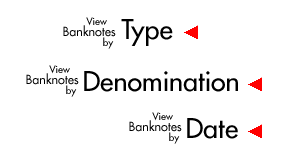
The theme of Series C Irish Legal Tender Notes is centred on the formation of modern Ireland in the nineteenth and twentieth centuries. The Series C notes were designed by the Irish artist Robert Ballagh, and the first of them, the £20 note, made its appearance in 1992. The last of the Irish Series C banknotes to be introduced was the Parnell Series C £100 note, in 1996.
The Central Bank of ireland Series C banknotes continued in circulation until Ireland joined the Eurozone as a founding member in 2002, whereupon all Irish banknotes were replaced by Euro notes in circulation. The final date of issue for an Irish Pound banknote was 8 March 2001 on a Series C 50 Pound note.
As early as the mid 1980s when the final denomination of the Series B banknotes, the £100 note, was still under development, there was already serious consideration by the Central Bank of ireland on the question of a radical size reduction in Ireland's currency notes [CBIAR].
It was also felt that the security of Irish banknotes notes themselves needed improvement and modernisation to bring the currency more into line with that of other European countries. This pushed the decision towards the introduction of the new Series C banknotes.
A limited competition took place in 1991 in which nine prominent Irish artists were invited to submit design entries for the Series C banknotes based on the theme. The artist Robert Ballagh won the competition, and all the Series C notes were designed by him.
The theme of the Irish Series C banknotes centres around important people in Irish history in the 19th and early 20th centuries, the era of the formation of modern Ireland.
The 19th century Irish politician and statesman Daniel O'Connell (1775-1847) is featured on the Series C £20 note, the first denomination of the new design Irish banknotes to enter circulation in 1992.
The Series C £5 note features the development of education and health in Ireland in the 19th century and bears a portrait of Catherine McAuley (1771-1811). The £10 Series C note features a portrait of James Joyce (1882-1941).
On the Series C £50 note is a portrait of Douglas Hyde (1860-1949), a scholar who was prominent in the revival of the Irish language. He also also the first President of Ireland.
The Series C £100 note continues the theme of Irish politics, and focuses on the latter part of the 19th century. The note features a portrait of Charles Stuart Parnell (1846-1891) who was an Irish Political leader in the United Kingdom house of Commons.
Listed following are the dates when each of the denominations of the Series C banknotes first entered circulation [CBI].
Series C £20 O'Connell, 6 November 1992.
Series C £10 Joyce, 17 September 1993.
Series C £5 McAuley, 15 April 1994.
Series C £50 Hyde, 3 November 1995.
Series C £100 Parnell, 13 September 1996.
The first denomination of Series C notes to enter circulation in November 1992 caused an immediate stir within the collector community within a few days when it was noticed that an anomalous BBB replacement note existed, with a date 10.09.92, earlier than the date on the first standard issue £20 Series C note, 21.09.92, which also existed as a BBB replacement note. The Central Bank of Ireland did not acknowledge the existence of the 10.09.92 date among the Series C banknotes.
The scramble was on to find an example of a Series C £20 note dated 10.09.92 in UNC. However, no such examples have been recorded, the highest grade recorded of this Series C £20 being About EF.
It appears, from observation, that a print run of 60,000 Series C £20 notes was made with the date 10.09.92. It is believed by the Irish collecting community to have been a trial run of some kind, numbered with a replacement note prefix so that the notes could be used up in the normal issuing process of the Series C £20 notes.
The date, 10.09.92 is also interestingly similar to the first date on all denominations of Series A banknotes. It is thought by the Irish collecting community that this interesting start date of the Irish Series C banknote issues is not a coincidence.
Despite being heavily sought-after, examples of the date are quite scarce, and it remains the rarest of the Series C banknotes.
Series C banknotes continued to use a complex prefixing system similar to that first used on Series B banknotes, based on a three letter cypher using the first twelve letters of the Roman alphabet, followed by a six digit number.
Later issues of Series C notes commencing in mid-1997 used the letters M to Z, excluding O and Q. Each prefix on the Series C banknotes was tied to a specific date of issue, making forgery more challenging.
Series C Replacement notes use a prefix of three letters the same: Five Pound notes - HHH, MMM; Ten Pound notes - JJJ, NNN; Twenty Pound notes - BBB, PPP; Fifty Pound notes - EEE, RRR; One Hundred Pound notes - KKK.
Irish Series C Specimen notes also carry a prefix of three letters the same. Zeros are used in the date and serial number fields on the Series C specimen notes. For Series C notes, all observed Specimen notes for each denomination carry the replacement note prefix for that denomination.
No Series C specimen notes have been seen with later series prefixes taken from the second half of the alphabet, although it would be logical for specimen notes to exist in the case of a signature change.
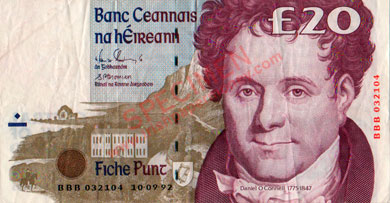
All denominations of Series C notes bear a similar watermark in the unprinted area of the note, that of a female head incorporating the denomination of the note in numerals. This watermark was adapted from the portrait of Lady Lavery which was used as a central feature on all denominations of the Series A Legal Tender Notes which circulated from 1928 to 1977.
Illustrated below is the watermark used on the Series C £100 note.
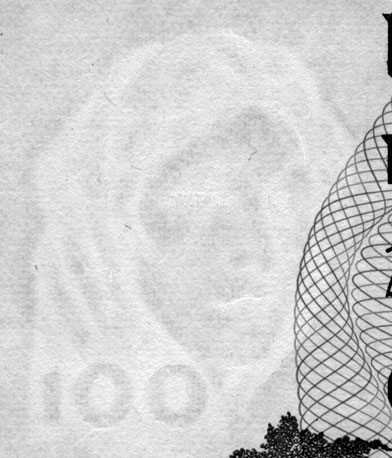
From their first introduction, all denominations of the Irish Series C Banknotes contained UV fluorescent features. Series C £5, £10, and £20 notes all incorporated an area to the left of the face of each note which fluoresces under ultra violet light. The intensity of fluorescence has been seen to vary across different notes.
In addition, the ink used to print the date and serial numbers on the bottom left of all Series C notes fluoresces under UV light.
The Series C £50 and £100 notes have more extensive UV fluorescent areas.
Microprinting is present on the face of all denominations of the Series C notes in varying locations, and also on the reverse of £20, £50, and £100 notes.
A ‘stardust’, or ‘windowed security thread’, incorporating the repeated denomination of the note in numerals runs through the middle of each denomination of the Series C banknotes. The security thread on Irish Series C notes is positioned slightly to the left of centre on the face of the £5, £10, and £20 denominations; and well to the left of centre on £50 and £100 denominations.
A shield is on the face and reverse of every Series C note. The face and reverse versions of this shield symbol each has different elements of a harp on it, which when held up to the light line up precisely with the same feature on the other side of the note to show a complete image of a harp.
A hidden latent image is printed on each Series C note which when tilted at an angle to the light reveals the letters ‘IR’.
Central Bank of Ireland Series C Specimen notes
Series C View by Type - Four Types of Legal Tender Notes by signature and design variation.
Series C View by Denomination - An example of each denomination for every Type.
View Series C notes by Date - An image of every date of each denomination.
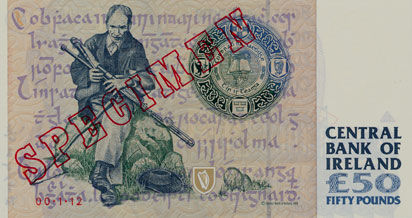
Dimensions are from measurements of actual banknotes. Note: the dimensions tended to vary by a millimetre or so, depending on the cut.
Series C £5 Note, 120 x 64 mm;
Series C £10 Note, 128 x 68 mm;
Series C £20 Note, 136 x 72 mm;
Series C £50 Note, 144 x 76 mm;
Series C £100 Note, 152 x 80 mm.
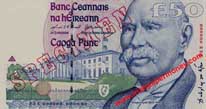
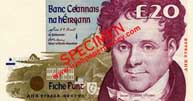


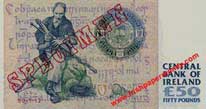



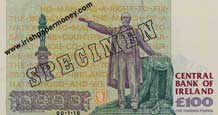
Below is a Central Bank of Ireland Documentary on youtube: Robert Ballagh – Designing the C Series Banknotes.
References
The content of this page is based partly on research carried out at the Central Bank of Ireland Archives, Dublin on 24 May 2018.
A. Central Bank of Ireland Publication 'The Design of Irish Banknotes'. Referred to as CBI in the text.
B. Central Bank of Ireland Archives, Dublin. Referred to as CBIAR in the text. [Accessed 24 May 2018].
Specimen images of Series C banknotes were loaned for scanning by the Central Bank of Ireland.
5 Pound Note, Sister Catherine McAuley
10 Pound Note, James Joyce
20 Pound Note, Daniel O'Connell
50 Pound Note, Douglas Hyde
100 Pound Note, Charles Stewart Parnell
![]()